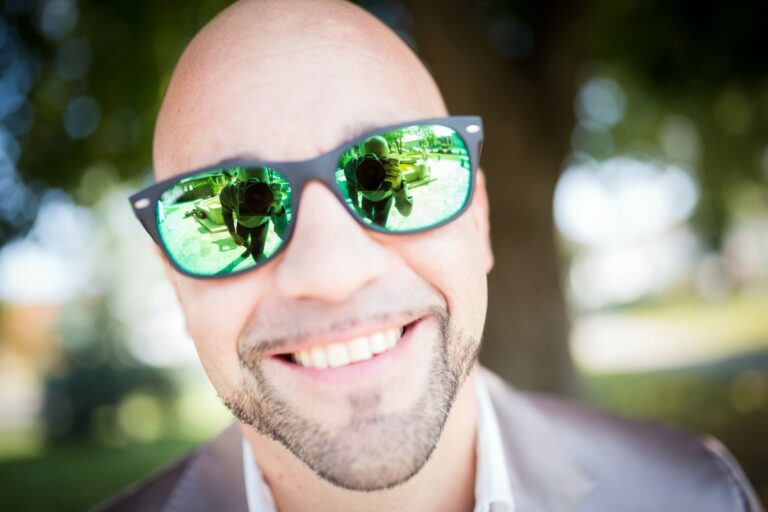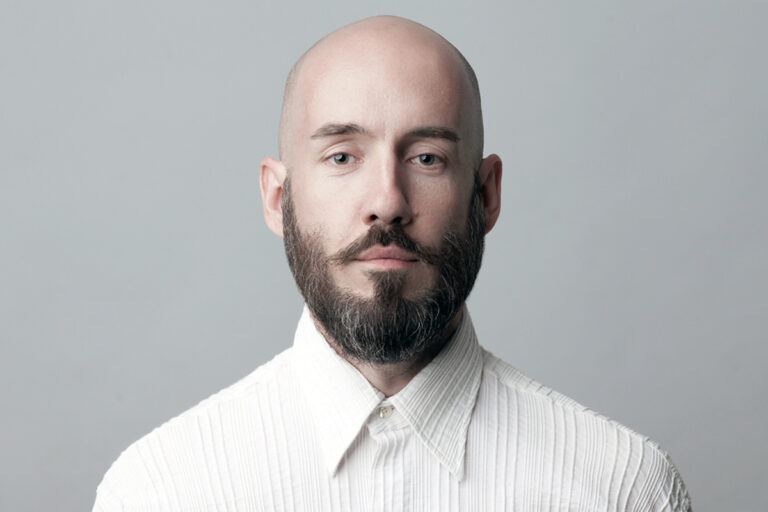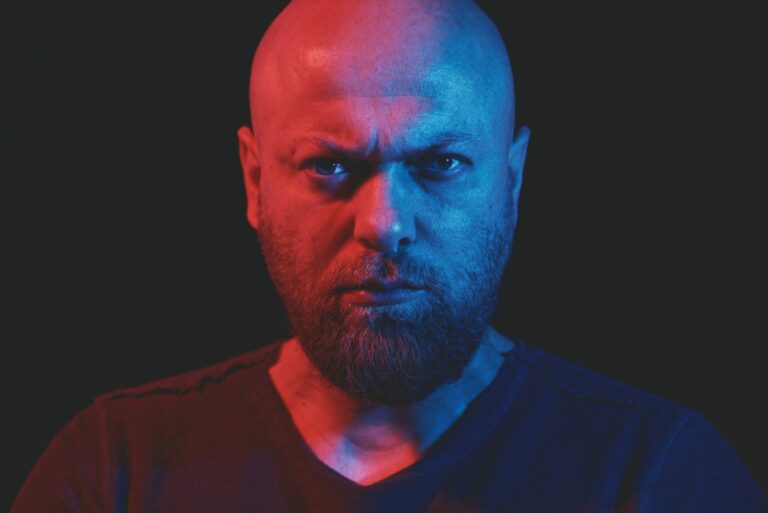How to Exfoliate Bald Head at Home 2024 (Scalp Exfoliation)

It took a long time for me to learn the importance of scalp exfoliation.
After each shave, I noticed my scalp got flaky and dry and it bothered me so much.
As it turned out, neglecting to exfoliate my scalp caused a buildup of dead skin cells, which led to an embarrassingly flaky and dry scalp.
So, to exfoliate bald head, apply a gentle exfoliant, massage in circular motions on a clean scalp, rinse, and follow with a dedicated moisturizer.
Here’s how to do it the right way.
- Types of Bald Head Exfoliants
- How to Exfoliate Your Bald Head
- How Often Should You Exfoliate Your Bald Head?
- Scalp Exfoliation Side-Effects
- Can You use a face exfoliator on your scalp?
- Should you exfoliate before or after shaving your head?
- Should you exfoliate before or after shampooing?
Types of Bald Head Exfoliants
There are two main types of bald head exfoliants: physical and chemical. Physical exfoliants (like scalp scrubs) are the most common as they are easy to use and really effective.
Most beginners should start out with bald head scrubbers and test chemical exfoliants if there’s an issue like an oily scalp or oversensitivity. (1)
Physical Exfoliants
Physical exfoliants are products that use tiny particles to manually remove dead skin cells from your scalp.
These scrubs are often made from natural ingredients such as sugar, salt, or crushed nut shells, mixed into a cream or gel.
They’re great for guys with normal to oily skin types because they help to unclog pores and reduce oiliness. (2)
I like bald head scrubs because I can control how vigorously I scrub and how deeply it will exfoliate my bald dome.
Protip: When choosing physical exfoliants, avoid harsh ingredients like artificial fragrances, dyes, harsh salts, and large beads, as they can cause microtears. Skip abrasive scrubs with irregular textures and prefer natural ingredients like sugar or oatmeal.
Chemical Exfoliants
Chemical exfoliants are skincare products that use acids like AHAs (glycolic acid) or BHAs (salicylic acid) to dissolve dead skin cells from your scalp.
They’re best for baldies with oily or combination skin types.
If you’ve got a shiny dome and are dealing with sensitive scalp, flaky skin or dandruff, a chemical exfoliant could be the right option to consider.
It goes deep into your skin, cleansing from the inside out, and leaving your scalp feeling fresh and clean.
Protip: Avoid using chemical exfoliants with concentrations above 10%, like glycolic acid at 15% or salicylic acid at 12%. Otherwise, they may lead to excessive sensitivity and irritation. Refrain from layering multiple strong exfoliants to prevent over-exfoliation and potential skin damage.
Scalp Brushes
A scalp brush is a gentle tool with soft bristles designed to exfoliate and stimulate blood circulation of your bald head. It helps remove dead skin cells and promote scalp health.
While the bald head exfoliator brush is pretty good on its own, it’s not always enough for a deep cleanse.
For a more thorough exfoliation, use it along with an exfoliating scalp cleanser or scrub. This combo will remove dead skin, unclog pores, and promote healthier skin.
I use a scalp brush for a regular scalp massage (it actually feels good) and the exfoliation effect is just a bonus.
Protip: When choosing a brush, consider your scalp’s sensitivity. Softer bristles for sensitive scalps, slightly firmer for normal scalps. Test the brush’s comfort on your hand, and ensure it’s easy to grip and maneuver during use.
Microdermabrasion Tools
Microdermabrasion tools are specialized bald head exfoliators that use tiny crystals to remove dead skin cells from your scalp.
These tools are best suited for normal to oily skin types but not so great if you have sensitive skin, as they can be a bit harsh.
What makes these tools unique in the field of dermatology is they offer a deep exfoliation, going beyond the surface layer of the scalp.
This can help reduce the appearance of skin discoloration and stimulate blood flow, leading to a healthier scalp.
However, these devices should be used with caution in accordance with dermatological guidelines, as overuse or improper use can potentially cause skin damage.
Protip: Avoid aggressive usage, especially with high abrasion settings above level 3. Refrain from overusing, limiting sessions to once a week to give your skin time to recover. Skip using on sensitive, irritated, or sunburned skin.
Exfoliating Shampoos
Exfoliating shampoos are specialized hair care products that cleanse and scrub away dead skin cells from your scalp.
They are just like physical exfoliators just combined with shampoos, saving you more time and money.
They’re ideal for oily or flaky scalps, typically containing ingredients like salicylic acid, tea tree oil, or fruit enzymes.
While this doesn’t provide the deepest exfoliation, I do like it because it saves me time, and I can minimize the number of bottles I have in my bathroom.
Protip: Avoid harsh sulfates, parabens, and strong fragrances that can irritate. Also, avoid high concentrations of exfoliants like salicylic acid above 2%, as they may cause over-exfoliation. Limit usage to 2-3 times a week to prevent scalp dryness.
How to Exfoliate Your Bald Head
The most common way to exfoliate your bald head is using head scrubs, and that’s why I’m writing about using them here.
Chemical exfoliators function similarly but need longer application times. (3) For other methods, just follow the instructions on the package.
- Choose the Right Time – Exfoliate during a shower when your scalp’s pores are open. Avoid exfoliating immediately after shaving to prevent irritation. Exfoliate 1-2 times a week for optimal results without overdoing it.
- Wet Your Scalp – Begin by wetting your scalp with lukewarm water. Warm water helps soften dead skin cells and prepares your scalp for exfoliation. Make sure the whole head is evenly wet.
- Apply the Exfoliator – Squeeze a small amount of the scrub onto your fingertips. Gently apply it to your damp scalp. Choose a scrub with fine particles to avoid abrasive effects.
- Massage in Circular Motions – Using light pressure, massage the scrub into your scalp with circular motions. Focus on areas prone to dryness or buildup, like the crown. Let the scrub’s texture do the work and avoid excessive pressure to prevent scalp irritation.
- Rinse Thoroughly – After 2-3 minutes of massaging, rinse your scalp thoroughly with lukewarm water. Ensure all scrub residues are removed. Use your fingertips to gently massage as you rinse to aid in thorough cleansing.
- Pat Dry – Gently pat your scalp dry with a clean, soft towel. Avoid rubbing, which can lead to friction and discomfort. If you have sensitive skin, opt for a microfiber towel to minimize irritation.
- Moisturize – As an aftercare, apply a lightweight, hydrating scalp moisturizer or oil to restore moisture after exfoliation. Look for moisturizers containing ingredients like aloe vera or hyaluronic acid to soothe and hydrate your scalp.
How Often Should You Exfoliate Your Bald Head?
Scalp exfoliation is an essential part of bald head care. Exfoliate your bald head 1-2 times per week. Over-exfoliating can lead to irritation and dryness, while under-exfoliating may not yield desired results.
Adjust the frequency based on your scalp’s response and avoid exfoliating on consecutive days to allow the skin time to recover.
I have made exfoliation as a key part of my skincare routine, and I usually exfoliate after every other head shave.
This way, my scalp doesn’t get too sensitive while still keeping it nice and clean.
Scalp Exfoliation Side-Effects
Scalp exfoliation isn’t always straightforward. While it offers benefits, there are often several side effects to be aware of.
- Irritation – Irritation occurs when the exfoliation process is too aggressive and disrupts the skin’s natural balance. This can lead to redness, inflammation, and discomfort. For instance, using a physical exfoliator with too large particles and scrubbing vigorously can cause irritation. To avoid this, opt for gentle exfoliants, apply light pressure during exfoliation, and gradually increase the intensity as your scalp becomes accustomed.
- Dryness – Over-exfoliation can strip away the protective oils that keep your scalp moisturized, causing it to become dry and flaky. Frequent use of strong chemical exfoliants, such as glycolic acid, can exacerbate dry scalp. To prevent dryness, limit exfoliation to 1-2 times a week and follow up with a moisturizing scalp oil or conditioner to replenish lost moisture.
- Sensitivity – Exfoliation can increase sensitivity, making your scalp more susceptible to external factors like UV rays and shaving. This heightened sensitivity is often observed after intense exfoliation methods, like microdermabrasion, without adequate sun protection. To minimize sensitivity, limit exfoliation to 1-2 times per week.
- Ingrown Hairs – Exfoliating your bald head too aggressively can lead to ingrown hairs. This happens when hair follicles become irritated, and hairs grow back into the skin instead of outward. Frequent use of harsh physical exfoliants, such as brushes with stiff bristles, can contribute to this issue. To prevent ingrown hairs, exfoliate gently in the direction of hair growth, consider alternative hair removal methods, and exercise caution when treating sensitive areas.
- Microtears – Microtears are another potential side effect of exfoliation. Harsh exfoliation methods can damage the protective barrier of the scalp, leading to small tears in the skin. Using abrasive physical exfoliants, like sugar scrubs, too aggressively can result in this issue. To avoid microtears, choose exfoliants with fine particles, apply minimal pressure during exfoliation, and adhere to recommended usage guidelines to ensure the safety and health of your scalp.
Can You use a face exfoliator on your scalp?
Yes, you can use a face exfoliator on your scalp as a short-term solution. But for long-term skin care, I prefer dedicated scalp exfoliators.
For long-term use, it’s not advisable to use a face exfoliator on your scalp because the scalp’s skin is thicker than facial skin, with more hair follicles and sebaceous glands.
The abrasive particles in face exfoliators are often designed for finer facial skin and may be too harsh for the scalp, potentially causing micro tears or irritation.
Additionally, the scalp’s skin can vary in thickness and sensitivity across different areas.
The scalp’s unique needs, such as combating dandruff or promoting hair growth, require specialized formulations that face exfoliators may not address.
Should you exfoliate before or after shaving your head?
The best time to exfoliate is before shaving your head. This removes dead skin cells and opens up pores, allowing you to get a smoother shave with less irritation and ingrown hairs.
Exfoliating after shaving can be riskier due to potential irritation.
Shaving can already cause mild abrasion and sensitivity, making post-shave exfoliation more likely to cause discomfort or redness.
Exfoliating right after shaving may also lead to overstimulation of the skin and potentially cause microtears.
Always moisturize after exfoliation and shaving to maintain a healthy scalp.
Should you exfoliate before or after shampooing?
The best time to exfoliate is before shampooing your head.
Prior exfoliation removes dead skin cells and buildup, allowing shampoo to cleanse more effectively.
Exfoliating after shampooing is less ideal, as it may undo the cleansing process.
Shampooing cleanses the scalp and hair, and exfoliating afterward could potentially remove essential natural oils. This might lead to dryness and discomfort.
Gently exfoliate with a scrub or brush to remove debris, then follow with shampoo to cleanse thoroughly.
Moisturize post-exfoliation and shampooing to maintain scalp health and ensure a clean bald head.







